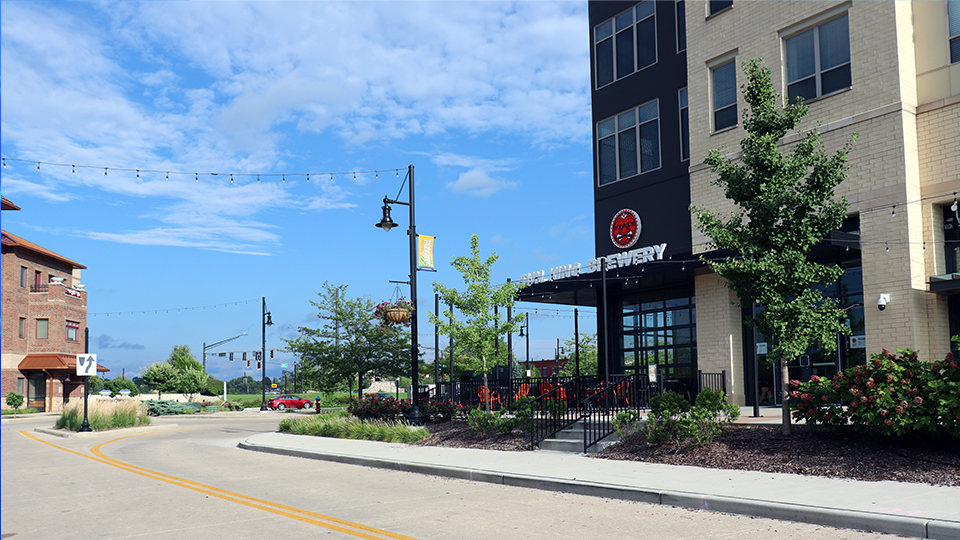Indiana cities aim for more vibrant downtowns with outdoor drinking areas
Subscriber Benefit
As a subscriber you can listen to articles at work, in the car, or while you work out. Subscribe Now
JASPER, Ind. - Last week, officials in Highland discussed the possibility of starting a DORA—or a designated outdoor refreshment area—in the center of the northwest Indiana town.
Days earlier, Zionsville’s town council passed a DORA encompassing the historic town center.
In mid-September, television cameras captured city officials in Mishawaka milling around the city’s riverfront area, beer cups in hand, to celebrate one of the state’s newest DORA districts.
Stemming from a law passed just last year by the legislature, DORAs are quickly becoming the norm around the state as Indiana communities large and small are hoping the ability to enjoy an adult beverage and walk around draws people to their downtowns.
The Indiana Alcohol and Tobacco Commission has now approved DORA districts for 23 communities in the state. Many more towns, like Zionsville, have passed ordinances setting up the specialty areas and those plans are now being reviewed by the ATC.
Though the DORA districts are very new, most municipalities say they’re seeing positive reviews.
“Since [April] we’ve got a very positive response from both residents and our local business in the district,” said Josh Gunsleman, the director of community development and planning for the city of Jasper. “We’ve really seen, to date, no negative impacts and only see it as a positive economic tool for us and our downtown.”
Generally speaking a DORA lets people over 21 over purchase alcoholic beverages from participating bars and restaurants and carry them outside and into other shops in the district that allow drinks.
Each town can tweak the hours the DORA is in effect and set their own boundaries on where the district covers. Most allow restaurants within the district to opt in or out of the DORA.
Jasper was an early adopter of the DORA, due to the bill’s author—Shane Lindauer—representing the area in the Statehouse. The city officially began DORA in January but didn’t begin its advertising campaign until the spring.
Gunsleman said the goal for Jasper isn’t just to boost alcohol sales at a few bars who participate. He said the city views its DORA as another piece to revitalizing its downtown, and the hope is to make a “third space” where people spend time dining and shopping and boosting the city’s overall growth.
“We’ve invested heavily in the last few years in revamping and revitalizing our downtown. So the DORA to us is an economic tool, just a layer we place over the same district we’re trying to reinvigorate,” Gunselman said.
In Jasper, city officials viewed the DORA as a component of a larger revitalization effort that included water line repairs and a multimillion-dollar beautification project.
Gunselman added the city plans to expand the DORA when it gets reapproved by the council this fall. He said a recent survey of the 10 approved vendors in the district led to half of the businesses saying the district has been a positive for them. Early returns for the first summer show there’s been about 1,000 cups sold, which equates to 1,000 individual trips to Jasper’s downtown.
Concerns over public intoxication delayed Mishawaka’s city council from approving a DORA back in 2023. After that year’s municipal election shifted the makeup of the council, Mishawaka now has a DORA district in and around the city’s scenic riverwalk.
Mishawaka Director of Development and Governmental Affairs Matthew Lentsch said he and others in the city had to educate vendors, officials and the public about the new concept.
“One of the things we had to do was educate on what it was and what it wasn’t,” he said. “That’s what we found out as we looked [at] some other places. It’s not about getting intoxicated. But it was about having fun with your family or friends and being able to walk around an area without restriction.”
But now that Mishawaka has had its DORA in effect for a month, the city is already seeing results. Lentsch said some businesses in the DORA district have told him they’ve seen a 30% increase in traffic compared to previous years.
Like Jasper and others, Lentsch said Mishawaka is considering expanding its current DORA or creating a new one due to popular feedback.
There has been scattered opposition as towns discuss their DORA plans. In Zionsville, one business owner worried about insurance premiums going up if his business was included in the district. In some towns the specialized districts supersede previous open-container laws meaning residents can no longer bring their own alcoholic drinks to outdoor events if they are within the DORA.
But those concerns haven’t stopped city after city from adopting DORAs in and around their downtowns.
Though it’s too early to get reliable data on DORAs, Gunselman points to Ohio, which passed legislation creating DORAs in 2015, as a guidepost. Ohio now has more than 150 DORA districts across the state, with most of them having expanded either their hours, their boundaries or both.
“We call it an economic tool because we hope this district will incentivize another business or two to come in and serve the needs of the community,” Gunselman said.
As of this month, the ATC has approved DORA district for the following towns: Bargersville, Batesville, Brookville, Fort Wayne, Greensburg, Griffith, Huntingburg, Jasper, Jeffersonville, Kirklin, Lafayette, Lawrenceburg, Logansport, Mishawaka, New Albany, Noblesville, Richmond, Roanoke, Shelbyville, Speedway, Warsaw, Winona Lake and Yorktown.
